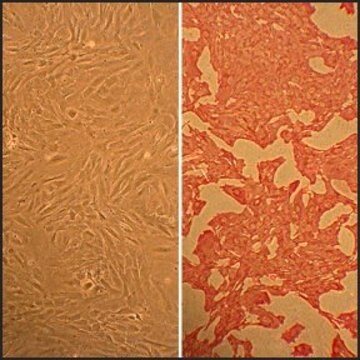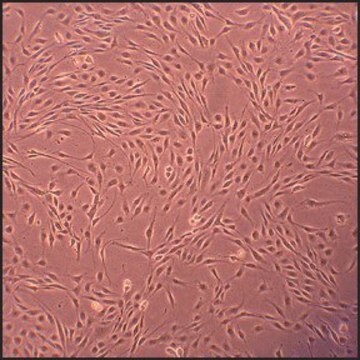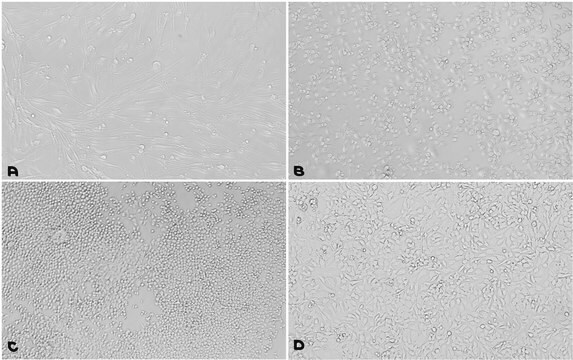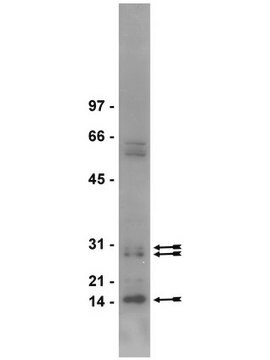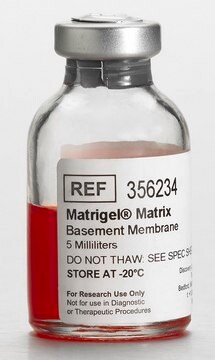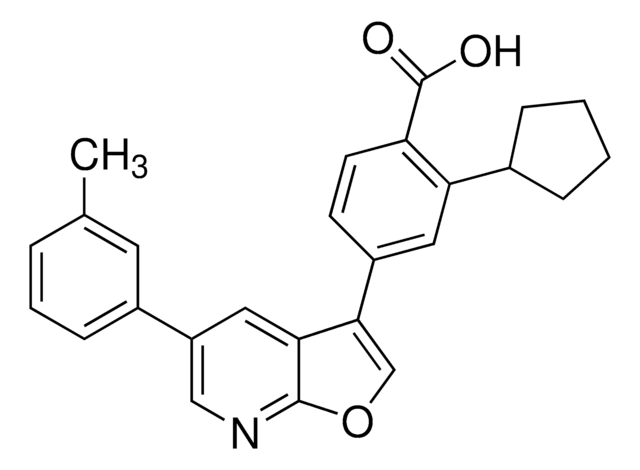R304-05A
Rat Aortic Endothelial Cells: RAOEC, adult
Synonim(y):
RAOEC cells
Zaloguj sięWyświetlanie cen organizacyjnych i kontraktowych
About This Item
Kod UNSPSC:
41106514
NACRES:
NA.81
Polecane produkty
pochodzenie biologiczne
rat aorta (adult)
opakowanie
pkg of 500,000 cells
producent / nazwa handlowa
Cell Applications, Inc
tryb wzrostu
Adherent
morfologia
Endothelial
metody
cell culture | mammalian: suitable
powiązane choroby
diabetes; cardiovascular diseases
temp. przechowywania
−196°C
Opis ogólny
Lot specific orders are not able to be placed through the web. Contact your local sales rep for more details.
RAOEC from Cell Applications, Inc. provide a useful model system to study many aspects of cardiovascular function and disease. Co-culture of the artery endothelial cells with species-matched smooth muscle cells provides an ideal model for studying the interaction between these two cell types.
RAOEC from Cell Applications, Inc. have been utilized in a number of research publications to:
Additionally, RAOEC from Cell Applications, Inc. were used to investigate the reasons for differential effects of Intermedin (IMD) on permeability of endothelial cells from different vascular beds (Aslam, 2011). Specifically, it was shown that IMD increased permeability of rat coronary microvascular endothelial cells by inducing loss of VE-cadherin from cel-cell junctions, but it reduced permeability of RAOEC and HUVECs because in those cell types IMD instead caused accumulation of VE-cadherin in cell-cell junctions. These differential effects of IMD on VE-cadherin are explained by the fact that, although IMD activates cAMP/PKA and inhibits RhoA/ROCK pathways leading to rearrangement of actin in both cell types, it only causes downstream Rac1 inhibition in rat coronary microvascular endothelial cells, but not in RAOEC or HUVEC. These results highlight the fundamental differences between endothelial cells from different vascular beds and/or microvascular vs. macrovascular endothelia.
RAOEC from Cell Applications, Inc. provide a useful model system to study many aspects of cardiovascular function and disease. Co-culture of the artery endothelial cells with species-matched smooth muscle cells provides an ideal model for studying the interaction between these two cell types.
RAOEC from Cell Applications, Inc. have been utilized in a number of research publications to:
- Investigate critical signaling pathways and mechanisms relevant to proper endothelial function, such as angiogenesis, proliferation, permeability, and search for beneficial modulators for therapeutic use (Sorensen, 2008; Liu, 2009; Makino, 2009; Masuda, 2012; Gros, 2013; Nguen, 2013)
- Elucidate molecular mechanisms of various cardiovascular risk factors, including those associated with diabetes, polycystic kidney disease, treatment for allograft rejection and vascular ER stress (Makino, 2008; Chiasson, 2011, Ren, 2011; Padilla, 2013)
- Provide a gold standard control for endothelial markers vWF and PECAM/CD31 expression (Hanley, 2008; Imamura, 2010)
- Develop drug delivery system for thrombolytic treatment (Mei, 2010)and methods for cardiac regeneration (Lionetti, 2010); design better vascular implants (Ibrahim, 2008; Yao, 2008; Duffy, 2011) and bone tissue engineering (Hamid, 2014)
Additionally, RAOEC from Cell Applications, Inc. were used to investigate the reasons for differential effects of Intermedin (IMD) on permeability of endothelial cells from different vascular beds (Aslam, 2011). Specifically, it was shown that IMD increased permeability of rat coronary microvascular endothelial cells by inducing loss of VE-cadherin from cel-cell junctions, but it reduced permeability of RAOEC and HUVECs because in those cell types IMD instead caused accumulation of VE-cadherin in cell-cell junctions. These differential effects of IMD on VE-cadherin are explained by the fact that, although IMD activates cAMP/PKA and inhibits RhoA/ROCK pathways leading to rearrangement of actin in both cell types, it only causes downstream Rac1 inhibition in rat coronary microvascular endothelial cells, but not in RAOEC or HUVEC. These results highlight the fundamental differences between endothelial cells from different vascular beds and/or microvascular vs. macrovascular endothelia.
Pochodzenie linii komórkowej
Aorta
Zastosowanie
Cardiovascular function, studies on immune system and graft rejection, development of 3D endothelialized engineered tissues, drug discovery, stent-graft compatibility testing.
Komponenty
Rat Endothelial Cell Basal Medium that contains 10% FBS and 10% DMSO
Jakość
Each lot was tested for proper morphology, Population Doublings, Negative for HIV, Hepatitis B, Hepatitis C, mycoplasma, bacteria, and fungi.
Uwaga dotycząca przygotowania
- 3rd passage, >500,000 cells in Rat Endothelial Cell Basal Medium that contains 10% FBS and 10% DMSO
- Can be cultured at least to 6th passage
Rutyna subkultury
Please refer to the RAOEC Culture Protocol.
Ta strona może zawierać tekst przetłumaczony maszynowo.
Kod klasy składowania
10 - Combustible liquids
Klasa zagrożenia wodnego (WGK)
WGK 1
Temperatura zapłonu (°F)
Not applicable
Temperatura zapłonu (°C)
Not applicable
Wybierz jedną z najnowszych wersji:
Certyfikaty analizy (CoA)
Lot/Batch Number
Przepraszamy, ale COA dla tego produktu nie jest aktualnie dostępny online.
Proszę o kontakt, jeśli potrzebna jest pomoc Obsługa Klienta
Masz już ten produkt?
Dokumenty związane z niedawno zakupionymi produktami zostały zamieszczone w Bibliotece dokumentów.
Klienci oglądali również te produkty
Mikhail A Kaplan et al.
Journal of biomaterials science. Polymer edition, 31(11), 1405-1420 (2020-04-24)
The novelty of the work lies in the creation and study of the physical and biological properties of biodegradable polymer coatings for stents based on poly(lactic-co-glycolic acid) (PLGA). Polymer coatings are capable of prolonged and directed release of molecules with
Nasz zespół naukowców ma doświadczenie we wszystkich obszarach badań, w tym w naukach przyrodniczych, materiałoznawstwie, syntezie chemicznej, chromatografii, analityce i wielu innych dziedzinach.
Skontaktuj się z zespołem ds. pomocy technicznej